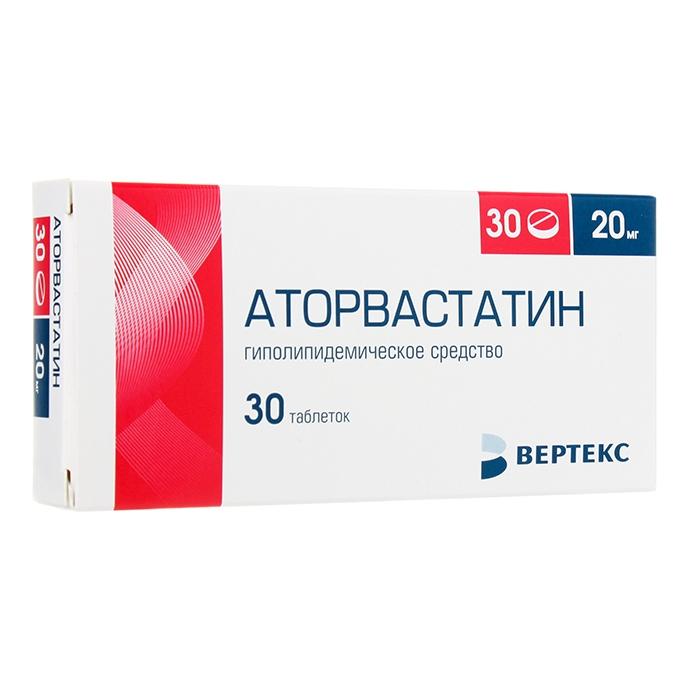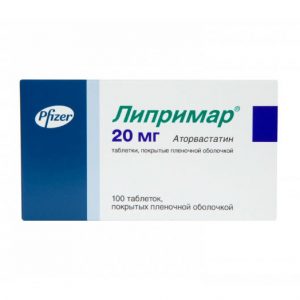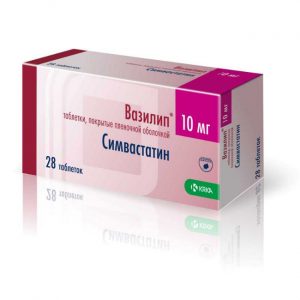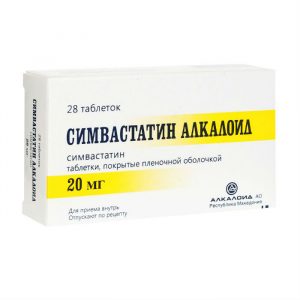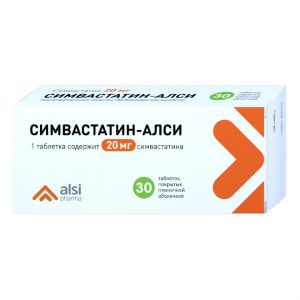Description
Release form
film-coated tablets
Packing
30 pcs.
Pharmacological action
Pharmacodynamics
Atorvastatin is a hypolipidemic agent from the group of statins. Selective competitive inhibitor of HMG-CoA reductase, an enzyme that converts 3-hydroxy-3-methylglutaryl coenzyme A to mevalonic acid, a precursor of sterols, including cholesterol. Triglycerides (TG) and cholesterol in the liver are included in the composition of very low density lipoproteins (VLDL), enter the blood plasma and are transported to peripheral tissues. Low density lipoproteins (LDL) are formed from VLDL during interaction with LDL receptors. Atorvastatin reduces plasma cholesterol and lipoprotein levels by inhibiting HMG-CoA reductase, synthesis of cholesterol in the liver and an increase in the number of hepatic LDL receptors on the cell surface, which leads to increased uptake and catabolism of LDL.
Reduces the formation of LDL, causes a pronounced and persistent increase in the activity of LDL receptors. Decreases LDL in patients with homozygous familial hypercholesterolemia, which usually does not respond to therapy with lipid-lowering drugs. It reduces the level of total cholesterol by 30-46%, LDL – by 41-61%, apolipoprotein B – by 34-50% and TG – by 14-33% causes an increase in the level of HDL cholesterol (high density lipoproteins) and apolipoprotein A. Dose-dependent lowers LDL levels in patients with homozygous hereditary hypercholesterolemia, resistant to therapy with other lipid-lowering drugs.
Pharmacokinetics
Absorption – High. The maximum concentration (Cmax) in plasma is reached after 1-2 hours, Cmax in women is 20% higher, the area under the curve / concentration, time (AUC) is 10% lower Cmax in patients with alcoholic cirrhosis by 16 times, AUC – 11 times higher than normal.
Food slightly reduces the speed and duration of absorption of the drug (by 25% and 9%, respectively), however, lowering LDL cholesterol is similar to that when using Atorvastatin without food. The concentration of Atorvastatin when applied in the evening is lower than in the morning (approximately 30%). A linear relationship between the degree of absorption and the dose of the drug was revealed.
Bioavailability – 12%, systemic bioavailability of inhibitory activity against HMG-CoA reductase – 30%. Low systemic bioavailability is due to a presystemic metabolism in the mucous membrane of the gastrointestinal tract and the first passage through the liver.
The average volume of distribution is 381 L, the connection with blood plasma proteins is 98%. It is metabolized mainly in the liver under the action of cytochrome CYP3A4, CYP3A5 and CYP3A7 with the formation of pharmacologically active metabolites (ortho- and para-hydroxylated derivatives, beta-oxidation products). In vitro, ortho- and para-hydroxylated metabolites have an inhibitory effect on HMG-CoA reductase, comparable to that of Atorvastatin. The inhibitory effect of the drug against HMG-CoA reductase is approximately 70% determined by the activity of circulating metabolites.
It is excreted in the bile after hepatic and / or extrahepatic metabolism (does not undergo severe enterohepatic recirculation).
The elimination half-life is 14 hours. The inhibitory activity against HMG-CoA reductase persists for about 20-30 hours due to the presence of active metabolites. Less than 2% of an oral dose is determined in the urine. It is not excreted during hemodialysis.
Indications of
in combination with a diet to reduce elevated levels of total cholesterol, cholesterol / LDL, apolipoprotein B and triglycerides and increase HDL cholesterol in patients with primary hypercholesterolemia, heterozygous familial and non-familial hypercholesterolemia and combined (mixed) hyperlipidemia (Fredrickson types IIa and IIb)
in combination with a diet for the treatment of patients with elevated serum levels of triglycerides (Fredrickson type IV) and patients with dysbetalipoproteinemia III, and III) which diet therapy does not provide an adequate effect of
to lower levels of total cholesterol and cholesterol / LDL in patients with homozygous familial hypercholesterolemia, when diet therapy and other non-pharmacological methods cheniya are not sufficiently effective.
Contraindications
hypersensitivity to the components of the drug Atorvastatin
active liver disease or increased activity of “liver” enzymes of unknown origin (more than 3 times compared with the upper limit of normal)
liver failure (severity rating according to Child-B and A classification )
pregnancy
lactation
age is up to 18 years (efficacy and safety have not been established).
Precautions: alcohol abuse, a history of liver disease, severe electrolyte imbalance, endocrine and metabolic disorders, hypotension, severe acute infections (sepsis), uncontrolled epilepsy, extensive surgery, trauma, and skeletal muscle disease.
Use during pregnancy and lactation
Atorvastatin is contraindicated during pregnancy and lactation (breastfeeding).
It is not known whether atorvastatin is excreted in breast milk. Given the possibility of adverse events in infants, if necessary, use of the drug during lactation should decide on the termination of breastfeeding.
Women of reproductive age should use adequate contraceptive methods during treatment. Atorvastatin can be prescribed to women of reproductive age only if their probability of pregnancy is very low, and the patient is informed about the possible risk of treatment for the fetus.
Special instructions
Before starting therapy with atorvastatin, the patient must be prescribed a standard hypocholesterol diet, which he must follow during the entire period of treatment.
The use of HMG-CoA reductase inhibitors to lower blood lipids can lead to a change in biochemical parameters that reflect liver function. Liver function should be monitored before starting therapy, 6 weeks, 12 weeks after starting atorvastatin and after each dose increase, and periodically, for example, every 6 months.
An increase in the activity of “liver” enzymes in the blood serum can be observed during therapy with atorvastatin. Patients with an increase in enzyme levels should be monitored until the enzyme levels return to normal. In the event that the values ​​of alanine aminotransferase (ALT) or aspartic aminotransferase (AST) are more than 3 times the level of the upper acceptable limit, it is recommended to reduce the dose of Atorvastatin or stop treatment.
Atorvastatin should be used with caution in patients who abuse alcohol and / or have liver disease. Active liver disease or a persistent increase in the activity of aminotransferases of unknown origin serve as contraindications to the appointment of Atorvastatin.
Treatment with atorvastatin may cause myopathy. The diagnosis of myopathy (muscle pain and weakness in combination with an increase in the activity of creatine phosphokinase (CPK) by more than 10 times compared with the upper limit of the norm) should be discussed in patients with common myalgia, pain or muscle weakness and / or a marked increase in CPK activity. Patients should be warned that they should immediately inform the doctor about the appearance of unexplained pain or weakness in the muscles, if they are accompanied by malaise or fever. Atorvastatin therapy should be discontinued if there is a marked increase in CPK activity or in the presence of confirmed or suspected myopathy.
The risk of myopathy in the treatment of other drugs of this class increased with the simultaneous use of cyclosporine, fibrates, erythromycin, nicotinic acid or azole antifungal agents. Many of these drugs inhibit the metabolism mediated by cytochrome P450 3A4 and / or drug transport.
Atorvastatin is biotransformed by CYP 3A4. When prescribing atorvastatin in combination with fibrates, erythromycin, immunosuppressive drugs, azole antifungal agents or nicotinic acid in lipid-lowering doses, the expected benefit and risk of treatment should be carefully weighed and patients should be regularly observed to detect muscle pain or weakness, especially during the first months of treatment and during periods of increasing doses of any drug. In such situations, periodic determination of CPK activity can be recommended, although such control does not prevent the development of severe myopathy.
When using Atorvastatin, as well as other drugs of this class, cases of rhabdomyolysis with acute renal failure due to myoglobinuria are described.
Atorvastatin therapy should be temporarily discontinued or completely discontinued if there are signs of a possible myopathy or a risk factor for the development of renal failure due to rhabdomyolysis (for example, severe acute infection, arterial hypotension, serious surgery, trauma, severe metabolic, endocrine and electrolyte disturbances and uncontrolled seizures) .
Before starting Atorvastatin therapy, it is necessary to try to achieve control of hypercholesterolemia by adequate diet therapy, increased physical activity, weight loss in patients with obesity and treatment of other conditions.
Patients should be warned that they should immediately consult a doctor if unexplained muscle pain or weakness occurs, especially if they are accompanied by malaise or fever.
Influence on ability to drive a car and work with mechanisms
No adverse effects of Atorvastatin on ability to drive a car and work with mechanisms were reported.
Composition
1 tablet, coated, contains:
active substance:
atorvastatin calcium trihydrate (in terms of atorvastatin) 20 mg
nutrients:
microcrystalline cellulose,
lactose monohydrate,
calcium carbonate,
crospovidone,
sodium carboxymethyl starch (sodium starch glycolate),
hyprolose (hydroxypropyl cellulose),
magnesium stearate
shell composition:
[hypromellose, talc, hyproly (hydroxypropyl cellulose), titanium dioxide] or [dry film coating mixture containing hypromellose (50.0%), talc (19%) ), hyprolose (hydroxypropyl cellulose) (19.4%), titanium dioxide (11.0%)]
Dosage and administration of
Before prescribing atorvastatin, the patient should be advised of a standard lipid-lowering diet, which he must continue to follow throughout the duration of therapy.
The initial dose is an average of 10 mg 1 time / day. The dose varies from 10 to 80 mg 1 time / day.
The drug can be taken at any time of the day with food or regardless of the meal time. The dose is selected taking into account the initial levels of cholesterol / LDL, the purpose of therapy and individual effect. At the beginning of treatment and / or during an increase in the dose of Atorvastatin, it is necessary to monitor plasma lipid levels every 2-4 weeks and adjust the dose accordingly.
Primary hypercholesterolemia and mixed hyperlipidemia, as well as type III and IV according to Fredrickson.
In most cases, a dose of 10 mg of Atorvastatin once daily is sufficient. A significant therapeutic effect is observed after 2 weeks, as a rule, and the maximum therapeutic effect is usually observed after 4 weeks. With prolonged treatment, this effect persists.
Homozygous familial hypercholesterolemia.
Assign in a dose of 80 mg 1 time per day.
The use of the drug in patients with renal failure and kidney disease does not affect the level of atorvastatin in the blood plasma or the degree of decrease in cholesterol / LDL when it is used, therefore, changing the dose of the drug is not required.
In case of liver failure, the dose should be reduced.
When using the drug in elderly patients, there were no differences in safety, effectiveness or achievement of the goals of lipid-lowering therapy in comparison with the general population.
Side effects
From the nervous system – more often 2% – insomnia, dizziness less than 2% – headache, asthenia, malaise, drowsiness, nightmares, paresthesia, peripheral neuropathy, amnesia, emotional lability, ataxia, facial paralysis, hyperkinesia, migraine, depression, hypesthesia, loss of consciousness.
On the part of the sensory organs: less than 2% – amblyopia, ringing in the ears, dryness of the conjunctiva, disturbed accommodation, hemorrhage in the retina, deafness, glaucoma, parosmia, loss of taste, perversion of taste.
From the side of the cardiovascular system: more often 2% – chest pain less than 2% – palpitations, vasodilation symptoms, orthostatic hypotension, increased blood pressure, phlebitis, arrhythmia, angina pectoris.
From the hemopoietic system: less than 2% – anemia, lymphadenopathy, thrombocytopenia.
From the respiratory system: usually 2% – bronchitis, rhinitis less than 2% – pneumonia, dyspnea, exacerbation of bronchial asthma, nosebleeds.
From the digestive system: more often 2% – nausea less than 2% – heartburn, constipation or diarrhea, flatulence, gastralgia, abdominal pain, decreased or increased appetite, dry mouth, belching, dysphagia, vomiting, stomatitis, esophagitis, glossitis, erosive and ulcerative lesions of the oral mucosa, gastroenteritis, hepatitis, biliary colic, cheilitis, duodenal ulcer, pancreatitis, cholestatic jaundice, impaired liver function, rectal bleeding, melena, bleeding gums, tenesmus.
From the musculoskeletal system: more often 2% – arthritis less often 2% – leg muscle cramps, bursitis, tendosynovitis, myositis, myopathy, arthralgia, myalgia, rhabdomyolysis, torticollis, muscle hypertonicity, joint contractures.
From the genitourinary system: more often 2% – urogenital infections, peripheral edema less often 2% – dysuria (including pollakiuria, nocturia, urinary incontinence or urinary retention, imperative urination), nephritis, hematuria, vaginal bleeding, nephrourolithiasis, metrorrhagia, epididymitis, decrease libido, impotence, violation of ejaculation.
From the skin: more than 2% – alopecia, xeroderma, increased sweating, eczema, seborrhea, ecchymosis, petechiae.
Allergic reactions: less than 2% – itchy skin, rash, contact dermatitis, rarely – urticaria, angioedema, facial edema, photosensitivity, anaphylaxis, erythema multiforme exudative (including Stevens-Johnson syndrome), toxic epidermal necrolysis Lyell’s syndrome).
Laboratory indicators: less than 2% – hyperglycemia, hypoglycemia, increased serum CPK, albuminuria.
Other: less than 2% – weight gain, gynecomastia, mastodynia, exacerbation of gout.
overdose
Treatment: no specific antidote, symptomatic therapy is performed.
Hemodialysis is ineffective.
Storage Conditions
In a dry, dark place at a temperature not exceeding 25 C.
Shelf life
2 years.
Deystvuyushtee substance
Atorvastatin
drugstore conditions
drugstore
dosage form
tablets
Prescription
Prescribed
For adults prescribed by a doctor
